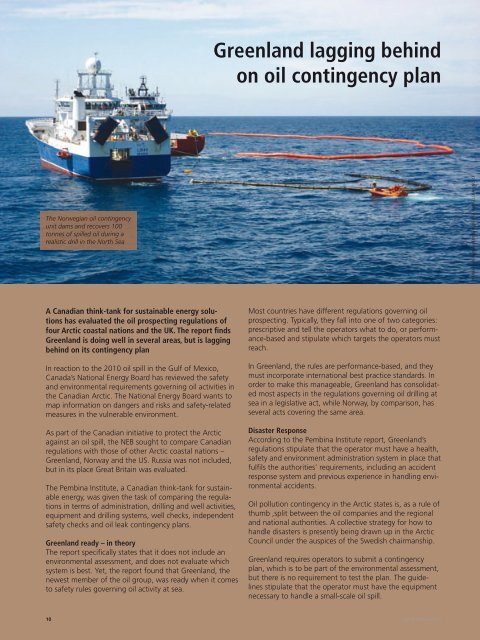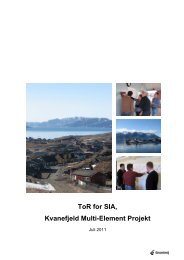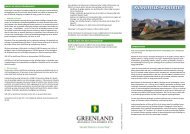Greenland Minerals
Greenland Minerals
Greenland Minerals
Create successful ePaper yourself
Turn your PDF publications into a flip-book with our unique Google optimized e-Paper software.
The Norwegian oil contingency<br />
unit dams and recovers 100<br />
tonnes of spilled oil during a<br />
realistic drill in the North Sea<br />
A Canadian think-tank for sustainable energy solutions<br />
has evaluated the oil prospecting regulations of<br />
four Arctic coastal nations and the UK. The report fi nds<br />
<strong>Greenland</strong> is doing well in several areas, but is lagging<br />
behind on its contingency plan<br />
In reaction to the 2010 oil spill in the Gulf of Mexico,<br />
Canada’s National Energy Board has reviewed the safety<br />
and environmental requirements governing oil activities in<br />
the Canadian Arctic. The National Energy Board wants to<br />
map information on dangers and risks and safety-related<br />
measures in the vulnerable environment.<br />
As part of the Canadian initiative to protect the Arctic<br />
against an oil spill, the NEB sought to compare Canadian<br />
regulations with those of other Arctic coastal nations –<br />
<strong>Greenland</strong>, Norway and the US. Russia was not included,<br />
but in its place Great Britain was evaluated.<br />
The Pembina Institute, a Canadian think-tank for sustainable<br />
energy, was given the task of comparing the regulations<br />
in terms of administration, drilling and well activities,<br />
equipment and drilling systems, well checks, independent<br />
safety checks and oil leak contingency plans.<br />
<strong>Greenland</strong> ready – in theory<br />
The report specifi cally states that it does not include an<br />
environmental assessment, and does not evaluate which<br />
system is best. Yet, the report found that <strong>Greenland</strong>, the<br />
newest member of the oil group, was ready when it comes<br />
to safety rules governing oil activity at sea.<br />
10<br />
<strong>Greenland</strong> lagging behind<br />
on oil contingency plan<br />
Most countries have different regulations governing oil<br />
prospecting. Typically, they fall into one of two categories:<br />
prescriptive and tell the operators what to do, or performance-based<br />
and stipulate which targets the operators must<br />
reach.<br />
In <strong>Greenland</strong>, the rules are performance-based, and they<br />
must incorporate international best practice standards. In<br />
order to make this manageable, <strong>Greenland</strong> has consolidated<br />
most aspects in the regulations governing oil drilling at<br />
sea in a legislative act, while Norway, by comparison, has<br />
several acts covering the same area.<br />
Disaster Response<br />
According to the Pembina Institute report, <strong>Greenland</strong>’s<br />
regulations stipulate that the operator must have a health,<br />
safety and environment administration system in place that<br />
fulfi ls the authorities’ requirements, including an accident<br />
response system and previous experience in handling environmental<br />
accidents.<br />
Oil pollution contingency in the Arctic states is, as a rule of<br />
thumb ,split between the oil companies and the regional<br />
and national authorities. A collective strategy for how to<br />
handle disasters is presently being drawn up in the Arctic<br />
Council under the auspices of the Swedish chairmanship.<br />
<strong>Greenland</strong> requires operators to submit a contingency<br />
plan, which is to be part of the environmental assessment,<br />
but there is no requirement to test the plan. The guidelines<br />
stipulate that the operator must have the equipment<br />
necessary to handle a small-scale oil spill.<br />
Oil & <strong>Minerals</strong> #2<br />
NORSK OLJEVERNFORENING FOR OPERATØRSELSKAP, NOFO






